From Nick Dolhin
(TVN Coordinator. Thank you very much for the advice you gave earlier in the year for stabilizing the beach cliff of Playa Carrizalillo in Pto. Escondido. We have come a long way with the project. In fact the first plantings of vetiver took so well that our client decided to increase the number of plants from the originally planned 25,000 to almost 65,000, equivalent of about 6 linear kilometers of hedgerow . Your advice on the planting strategy has been very useful and paid off with excellent results so far).
Puerto Escondido in the State of Oaxaca, southern Mexico, is a small resort on the Pacific coast, popular with international surfers and local tourists. This stretch of coast was badly damaged by Hurricane Paulina in October 1998 and again by the earthquake in September last year.
We were asked to install the vetiver grass system to protect a housing development being built above an eroding beach cliff. The most serious problems are large areas of loose sands, which were previously protected by the natural vegetation, and slides of the cliff top. Photo 1 gives an general view of about one half of the site which is 850 meters in total along the cliff top.
photo 1
The climate on the coast is hot and seasonally humid, with an average temperature above 26 degrees Celsius receiving about 1600 to 1800mm annually of rainfall. The rainy season normally starts in mid June with a six week break from mid August to end September, and terminates in mid October.
Vetiver can be planted at any time during the year, providing there is irrigation. The heavy downpours experienced from time to time cause most of the soil erosion, however exposed sandy on steep slopes slip of themselves when dried out. The rains have become less regular and predictable in recent years which makes planning for planting difficult in rainfed sites as the vetiver needs at least a month of good humidity in the soil to root effectively.
We were asked to protect the exposed areas and the cliff top which were suffering alarming water erosion and slides caused by the earthquake destabilization. The erosion of the cliff head was also exacerbated by a badly designed road which channels large quantities of rainwater onto the open flat area above the cliff; the water seeps deep down behind the cliff face further destabilizing it and also causes erosion of the lip despite attempts at engineered drainage channels. Photos 2 and 3 give an idea of the slopes involved which have gradients of between 45 and 85 degrees.
Photo 2 and 3
Large gabions filled with soil and laid horizontally to the cliff were initially tried to halt the erosion in the steep, exposed areas as shown in Photo 4. The gabions are expensive, have a relatively short lifetime and 40% slipped in the earthquake. Vetiver was chosen as an alternative to engineering solutions because it enhances the natural environment and because of its deep root system, resistance to drought and very poor soils, its ability to both slow and divert flowing water and long life.
Photo 4
The planting strategy, given we had 25,000 plantings slips initially, was to:
Photos 5 and 6
b) dense-plant on selected exposed cliff-face sites using the trimmed leaves for moisture retention and mulch as shown in Photo 7 and 8.
Photos 7 abd 8
Vetiver plants rooted in bags were recommended because the soils suffering the most serious erosion and in most urgent need of protection lack organic matter. However, the first planting gave impressive results so the client asked us to increase the planting. In the event, three types of plant material have been used:
Photo 9, 10 11
Manure was not used for all the plantings and the comparison between manured and unmanured plants is significant. Animal manure has increased plant growth and speed of rooting and decreased plant deaths. For bagged plants manure is preferably mixed in the substrate. For the rooted and clump slips in the sandy areas, application of manure has reduced plant deaths from about 30% to 10% and leaf growth increased by about 100%.
Several planting techniques have been tried to suit the different types of terrain:
A. Shallow incline (0 to 5 degrees). Standard hedgerows were planted the length of the cliff top using mostly bagged plants into order to get rapid root penetration to stabilize the substrate where water accumulates behind the cliff. Thirteen to fifteen bags per meter were planted to achieve an instant barrier to divert the flowing water. Photo 2 shows the cliff top barrier, the water flows from left to right, Photo 12 is a close up of the same hedgerow six weeks after planting. Photo 13 shows hedgerows more closely spaced than required by the incline in order to increase root surface below ground as this is an area of potential landslide; these hedgerows are also designed to divert surface water into the already protected area on the horizon.
Photos 12 and 13
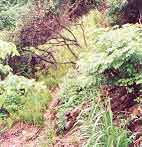

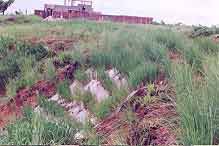
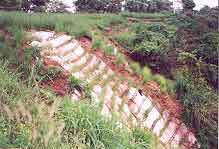
- Photos 14, 15, 16 and 17
D. Cliff path. The stairs leading down to the beach were eroding very rapidly, the sides being mostly loose sand. Photos 18 to 23 show sections of the path before and after planting. The steps were reconstructed to drain the water to the side run-offs which were protected with vetiver and the steep slopes filled with close random planting of vetiver or very close hedgerows. In some places the slope was too steep and sandy for the vetiver to withstand slippage caused by moderately heavy rainfall without wood stake retainers, upstream protection or very dense planting. The work is still in progress.
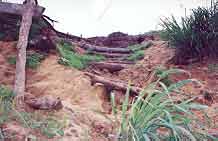

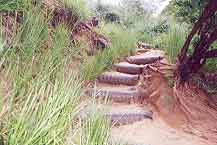
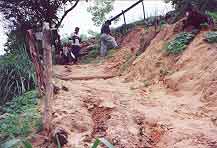
Photos 18, 19, 20, 21
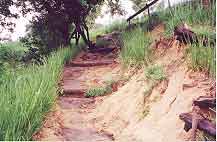
Photos 22 and 23
Trimming and weeding is a continuous process during the rainy season. The vetiver is trimmed and weeded on average once every two weeks. Leaves grow about 15 cm in a week. Weeds, in places guinea grass, can smother the vetiver within two weeks. Photo 24 shows the effect of weed shade on a hedgerow. The grass has been watered three times a week when rainfall has been insufficient to maintain good soil humidity.
Photo 24
A full time team of six was trained over three days in mid June at the onset of the rainy season. The team works six days a week on a fixed wage which means progress is slower than on piece rates but has the important advantage that the men can work at their natural rhythm and with greater care in planting slips. Following the training, twenty three days of monitoring and training in special techniques were given during the first two months. The foreman rapidly understood the vetiver and is making an excellent job of planting and maintenance. Since the two months monitoring, we have made occasional visits to sort out problems, which have been very few, and to discuss the client’s and foreman’s plans for planting new areas. Photo 25 shows the local team during training.
Photo 25
Lessons learnt.
Vetiver lives up to its name as an exceptional grass for stabilizing difficult sites and very poor soils. Attention to designing the site, selecting plant material and to planting and maintenance is needed to get good results.
As well as confirming the researched needs for the successful application of the vetiver grass system, our experience with this project highlights the following:
In difficult situations, such as unstable soils or steep slopes, experiment to get the best solution – vetiver is very versatile.
Quality of plant material is crucial: to obtain sure and rapid results bagged plants (when roots have extended to the bottom of the bag) or rooted slips (soaked in water inducing new roots after 5 to 10 days) are preferable;
Manure significantly increases root and leaf growth and reduces failures in poor soils;
Shade whether from weeds or trees badly affects plant growth; robust weeds can kill newly planted slips.
Involve the client and the people in charge of the planting in planning and design of the site from the beginning. The success of this project is resulting as much from the enthusiasm and commitment of the client and his work team as much from the remarkable properties of vetiver grass.
For a new client, rapid results generate enthusiasm and confidence and the willingness to experiment – it is worth spending time and money to ensure that the first demonstrations are as near 100% effective as possible.
Training is very important to ensure careful planting and good maintenance. When training the work team of a client, as in this case, ensuring that the foreman is fully conversant with the vetiver grass system so that he can make his own decisions and adopts the vetiver as his own project is well worth extra time in monitoring and supervision.
Planting began in mid June at the onset of the rains and is continuing at the time of writing. Weeding and trimming is a continuous process as, during this season, weeds can smother the vetiver within 2 weeks and vetiver leaf growth is about 15 cm a week in some sections of hedgerow. Three types of planting material have been used: slips in bags with rich alluvial soil but no fertilizer (see Photo 2), slips soaked in water for between five and ten days to induce new root growth (see Photo 4) before planting, and slips direct from division of the clump (Photo 5 which also shows trimming of the leaves prior to planting). Manure was applied to some sections of hedgerow and cliff-face particularly steep, sandy areas planted with slips rather from bags after bagged plants ran out. A core team of 6 people, including the foreman, working 6 days a week is responsible for planting and maintenance, sometimes supplemented by casual labor. By the end of this season’s planting, we expect to have planted the equivalent of 10 kms. of hedgerow.
The local team was trained at the outset over three days and 23 days of supervision/training were provided during the first 2 months visits. Since then occasional visits have been made to keep contact, take photographs and see if there are any problems (which there have not been so far).
In the steep, unstable, sandy areas we have tried four options: planting in closely spaced rows on the contour (Photo 6), dense scattered/random planting (Photo 7), rows supported by wooden stakes (Photo 8), and planting through felt sheets (Photo 9).
Three sections of the site are described in more detail below: the cliff top, the stairs leading from the cliff top to the beach, and a section of exposed cliff-face.
Cliff top.
Planting of the first section of the cliff top began in mid June at the onset of the rains with slips from bags. The idea was to get the vetiver going on the cliff to get as deep as possible root penetration before the heavy rains and to use this easy planting site for training the local vetiver team. The soils here contain some organic matter and fertilizer was only applied in some sections. In this section there has been no apparent difference between fertilized and unfertilized sections. This is probably because the manure was very “fresh”. Later planting in other locations when the manure had matured, has noticeably speeded up growth of the vetiver. The hedgerows were watered three time a week on average after planting when rainfall was insufficient to maintain humidy in the soil/sand. Photo 6/10 shows a close up of the vigorous growth of the first hedgerow planted (shown in Photo 3) after 8 weeks and one trimming. Leaf growth has been approximately 15 cm per week and in some places roots penetrated to over a meter in 6 weeks. Photos 7/11 and 8/12 give a general view of a section of the cliff top hedgerows before and 6 to 8 after planting. Photo 9/13 shows the arrangement of hedgerows which are designed to reduce run-off coming from the right of the picture and to provide protection from advance of the cliff face from the left, and to reduce earthquake damage in the long term. Given the soil and climate conditions we hope for roots systems penetrating up to 5 meters.
Beach stairway.
Cliff face.
The steep, exposed sandy areas were first planted with closely spaced hedgerows on the contour as shown in Photo X. These however tended to slip.